

Compact Muon Solenoid
LHC, CERN
| CMS-HIG-21-011 ; CERN-EP-2023-132 | ||
| Search for a new resonance decaying into two spin-0 bosons in a final state with two photons and two bottom quarks in proton-proton collisions at $ \sqrt{s} = $ 13 TeV | ||
| CMS Collaboration | ||
| 2 October 2023 | ||
| JHEP 05 (2024) 316 | ||
| Abstract: A search for a new boson X is presented using CERN LHC proton-proton collision data collected by the CMS experiment at $ \sqrt{s} = $ 13 TeV in 2016-2018, and corresponding to an integrated luminosity of 138 fb$ ^{-1} $. The resonance X decays into either a pair of Higgs bosons HH of mass 125 GeV or an H and a new spin-0 boson Y. One H subsequently decays to a pair of photons, and the second H or Y, to a pair of bottom quarks. The explored mass ranges of X are 260-1000 GeV and 300-1000 GeV, for decays to HH and to HY, respectively, with the Y mass range being 90-800 GeV. For a spin-0 X hypothesis, the 95% confidence level upper limit on the product of its production cross section and decay branching fraction is observed to be within 0.90-0.04 fb, depending on the masses of X and Y. The largest deviation from the background-only hypothesis with a local (global) significance of 3.8 (2.8) standard deviations is observed for X and Y masses of 650 and 90 GeV, respectively. The limits are interpreted using several models of new physics. | ||
| Links: e-print arXiv:2310.01643 [hep-ex] (PDF) ; CDS record ; inSPIRE record ; HepData record ; CADI line (restricted) ; | ||
| Figures & Tables | Summary | Additional Figures | References | CMS Publications |
|---|
| Figures | |

png pdf |
Figure 1:
Feynman diagram showing a tree-level gluon-gluon fusion production of a BSM resonance X decaying to a pair of spin-0 bosons (HH or HY), which then decay to the $ \gamma\gamma\mathrm{b}\overline{\mathrm{b}} $ final state. |

png pdf |
Figure 2:
The $ m_{\gamma\gamma} $ (upper left), $ m_\text{jj} $ (upper right) and $ m_{\gamma\gamma\text{jj}} $ (lower) distributions in data and MC simulations. The $ m_\text{jj} $ distribution starts at 70 GeV. The signal distributions, shown for different values of $ m_{\mathrm{X}} $ and $ m_{\mathrm{Y}} $ with an assumption of 1 fb cross section, have been scaled by a factor of 10$^3 $. |

png pdf |
Figure 2-a:
The $ m_{\gamma\gamma} $ distribution in data and MC simulations. The distribution starts at 100 GeV. The signal distributions, shown for different values of $ m_{\mathrm{X}} $ and $ m_{\mathrm{Y}} $ with an assumption of 1 fb cross section, have been scaled by a factor of 10$^3 $. |

png pdf |
Figure 2-b:
The $ m_\text{jj} $ distribution in data and MC simulations. The distribution starts at 70 GeV. The signal distributions, shown for different values of $ m_{\mathrm{X}} $ and $ m_{\mathrm{Y}} $ with an assumption of 1 fb cross section, have been scaled by a factor of 10$^3 $. |
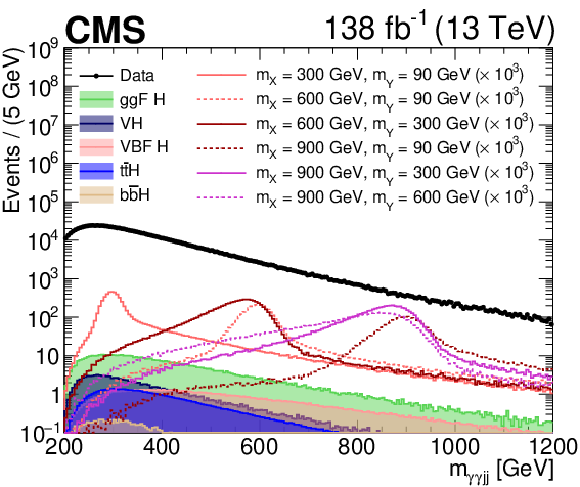
png pdf |
Figure 2-c:
The $ m_{\gamma\gamma\text{jj}} $ distribution in data and MC simulations. The distribution starts at 200 GeV. The signal distributions, shown for different values of $ m_{\mathrm{X}} $ and $ m_{\mathrm{Y}} $ with an assumption of 1 fb cross section, have been scaled by a factor of 10$^3 $. |

png pdf |
Figure 3:
The distribution of BDT output in data and MC simulations for a signal in $ m_{\mathrm{X}} $ = 500-700 GeV and $ m_{\mathrm{Y}} < $ 300 GeV range. The signal distribution, with an assumption of 1 fb cross section, has been scaled by a factor of 10$^3 $. |

png pdf |
Figure 4:
$ \widetilde{M}_{\mathrm{X}} $ selection for each $ m_{\mathrm{X}} $ in HH and HY signals. The red and green lines represent the upper and lower boundary of this selection. |
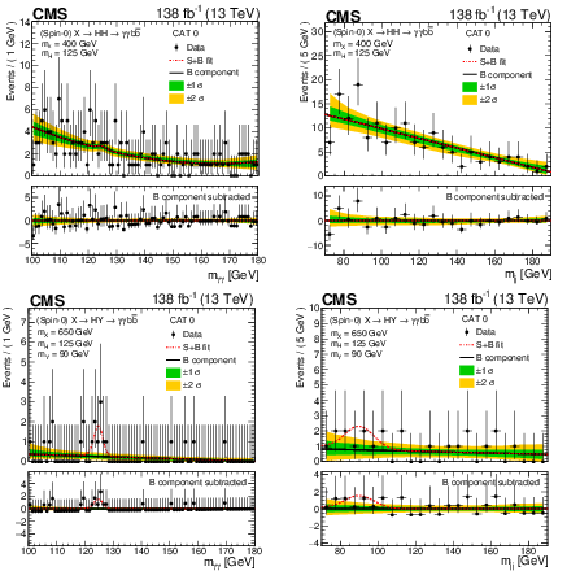
png pdf |
Figure 5:
Invariant mass distributions $ m_{\gamma\gamma} $ (left) and $ m_\text{jj} $ (right) with the data events (black markers), with $ \widetilde{M}_{\mathrm{X}} $ selection corresponding to an HH signal with $ m_{\mathrm{X}} $ = 400 GeV (upper panel), and to an HY signal with $ m_{\mathrm{X}} $ = 650 GeV and $ m_{\mathrm{Y}} $ = 90 GeV (lower panel). The distributions are shown for the signal-dominated category (CAT 0). The red dashed line shows the sum of the fitted signal and background events. The solid black line shows the total background component by summing the resonant and nonresonant background contributions. The green and yellow bands represent the $ \pm $1- and $ \pm $2-standard deviations which include the uncertainties in fit to the background component. The lower panel in each plot shows the residual signal yield after the background subtraction. |

png pdf |
Figure 5-a:
Invariant mass distribution $ m_{\gamma\gamma} $ with the data events (black markers), with $ \widetilde{M}_{\mathrm{X}} $ selection corresponding to an HH signal with $ m_{\mathrm{X}} $ = 400 GeV. The distributions are shown for the signal-dominated category (CAT 0). The red dashed line shows the sum of the fitted signal and background events. The solid black line shows the total background component by summing the resonant and nonresonant background contributions. The green and yellow bands represent the $ \pm $1- and $ \pm $2-standard deviations which include the uncertainties in fit to the background component. The lower panel shows the residual signal yield after the background subtraction. |
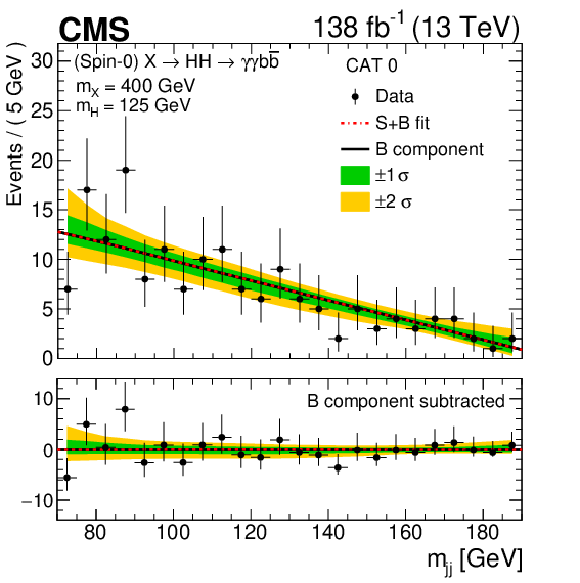
png pdf |
Figure 5-b:
Invariant mass distribution $ m_\text{jj} $ with the data events (black markers), with $ \widetilde{M}_{\mathrm{X}} $ selection corresponding to an HH signal with $ m_{\mathrm{X}} $ = 400 GeV. The distributions are shown for the signal-dominated category (CAT 0). The red dashed line shows the sum of the fitted signal and background events. The solid black line shows the total background component by summing the resonant and nonresonant background contributions. The green and yellow bands represent the $ \pm $1- and $ \pm $2-standard deviations which include the uncertainties in fit to the background component. The lower panel shows the residual signal yield after the background subtraction. |
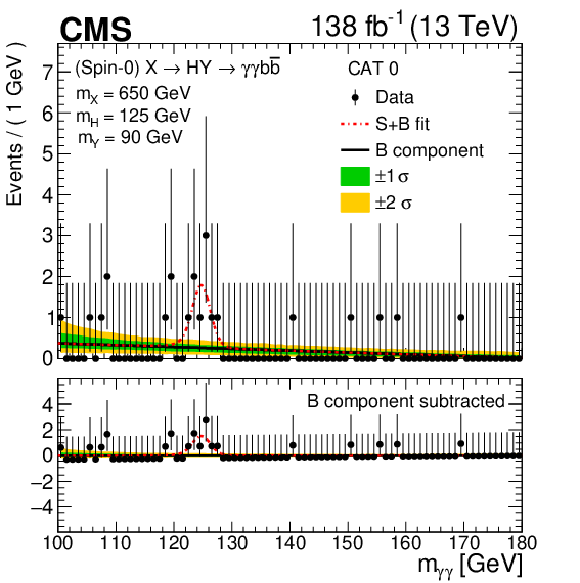
png pdf |
Figure 5-c:
Invariant mass distribution $ m_{\gamma\gamma} $ with the data events (black markers), with $ \widetilde{M}_{\mathrm{X}} $ selection corresponding to an HY signal with $ m_{\mathrm{X}} $ = 650 GeV and $ m_{\mathrm{Y}} $ = 90 GeV. The distributions are shown for the signal-dominated category (CAT 0). The red dashed line shows the sum of the fitted signal and background events. The solid black line shows the total background component by summing the resonant and nonresonant background contributions. The green and yellow bands represent the $ \pm $1- and $ \pm $2-standard deviations which include the uncertainties in fit to the background component. The lower panel shows the residual signal yield after the background subtraction. |

png pdf |
Figure 5-d:
Invariant mass distribution $ m_\text{jj} $ with the data events (black markers), with $ \widetilde{M}_{\mathrm{X}} $ selection corresponding to an HY signal with $ m_{\mathrm{X}} $ = 650 GeV and $ m_{\mathrm{Y}} $ = 90 GeV. The distributions are shown for the signal-dominated category (CAT 0). The red dashed line shows the sum of the fitted signal and background events. The solid black line shows the total background component by summing the resonant and nonresonant background contributions. The green and yellow bands represent the $ \pm $1- and $ \pm $2-standard deviations which include the uncertainties in fit to the background component. The lower panel shows the residual signal yield after the background subtraction. |

png pdf |
Figure 6:
Expected and observed 95% CL upper limit on the product of resonant production cross section and branching fraction for spin-0 (upper) and spin-2 (lower) $ \mathrm{p}\mathrm{p} \to \mathrm{X} \to \mathrm{H}\mathrm{H} \to \gamma\gamma\mathrm{b}\overline{\mathrm{b}} $ signal hypotheses. The dashed and solid black lines represent expected and observed limits, respectively. The green and yellow bands represent the $ \pm $1 and $ \pm $2 standard deviations for the expected limit. The red lines show the theoretical predictions with different energy scales and couplings. |

png pdf |
Figure 6-a:
Expected and observed 95% CL upper limit on the product of resonant production cross section and branching fraction for the spin-0 $ \mathrm{p}\mathrm{p} \to \mathrm{X} \to \mathrm{H}\mathrm{H} \to \gamma\gamma\mathrm{b}\overline{\mathrm{b}} $ signal hypothesis. The dashed and solid black lines represent expected and observed limits, respectively. The green and yellow bands represent the $ \pm $1 and $ \pm $2 standard deviations for the expected limit. The red lines show the theoretical predictions with different energy scales and couplings. |
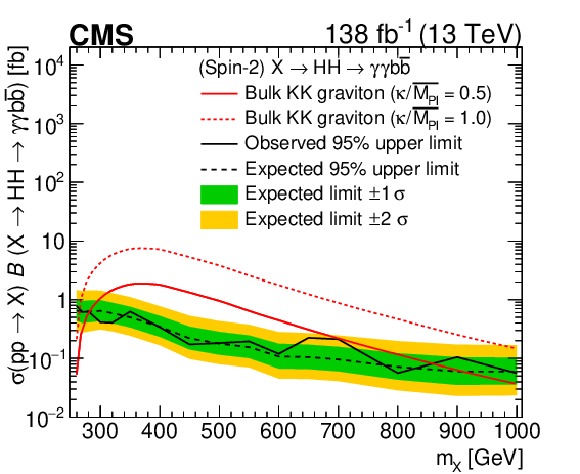
png pdf |
Figure 6-b:
Expected and observed 95% CL upper limit on the product of resonant production cross section and branching fraction for the spin-2 $ \mathrm{p}\mathrm{p} \to \mathrm{X} \to \mathrm{H}\mathrm{H} \to \gamma\gamma\mathrm{b}\overline{\mathrm{b}} $ signal hypothesis. The dashed and solid black lines represent expected and observed limits, respectively. The green and yellow bands represent the $ \pm $1 and $ \pm $2 standard deviations for the expected limit. The red lines show the theoretical predictions with different energy scales and couplings. |

png pdf |
Figure 7:
Expected and observed 95% CL exclusion limit on production cross section for $ \mathrm{p}\mathrm{p} \to \mathrm{X} \to \mathrm{H}{\mathrm{Y}} \to \gamma\gamma\mathrm{b}\overline{\mathrm{b}} $ signal. The dashed and solid black lines represent expected and observed limits, respectively. The green and yellow bands represent the $ \pm $1 and $ \pm $2 standard deviations for the expected limit. The middle plot in the 3rd row shows the highest excess observed for $ m_{\mathrm{X}} $ = 650 GeV and $ m_{\mathrm{Y}} $ = 90 GeV. |

png pdf |
Figure 8:
Comparison of the expected (left) and observed (right) limits at 95% CL with the maximally allowed cross sections from the NMSSM model where the area within the red contours indicate the excluded mass regions. The limits are displayed as two-dimensional binned distributions. |

png pdf |
Figure 8-a:
Expected limits at 95% CL with the maximally allowed cross sections from the NMSSM model where the area within the red contours indicate the excluded mass regions. The limits are displayed as two-dimensional binned distributions. |

png pdf |
Figure 8-b:
Observed limits at 95% CL with the maximally allowed cross sections from the NMSSM model where the area within the red contours indicate the excluded mass regions. The limits are displayed as two-dimensional binned distributions. |
| Tables | |

png pdf |
Table 1:
Event preselection criteria. |

png pdf |
Table 2:
The BDT based event classification according to defined $ m_{\mathrm{X}} $ (and $ m_{\mathrm{Y}} $) ranges for HH (and HY) searches. For HH searches, the column with $ m_{\mathrm{Y}} < $ 300 GeV is used. The number represents the BDT scores showing a decreasing signal purity region from category 0 to 2. |
| Summary |
| A search for a new resonance X, decaying either to a pair of Higgs bosons HH or to an H and a new spin-0 boson Y, is presented. The search uses data from proton-proton collisions collected by the CMS experiment at the Large Hadron Collider in 2016-2018 at a center-of-mass energy of 13 TeV, corresponding to 138 fb$ ^{-1} $ of integrated luminosity. The search targets beyond standard model particles as predicted by several models of new physics. For X decaying to HH, an $ m_{\mathrm{X}} $ range of 260-1000 GeV is covered, while for X decaying to HY, the search range is 300-1000 GeV in $ m_{\mathrm{X}} $ and 90-800 GeV in $ m_{\mathrm{Y}} $. Results are presented as the upper limits at 95% confidence level on the product of the production cross section of X and its branching fraction to the $ \gamma\gamma\mathrm{b}\overline{\mathrm{b}} $ final state, through either HH or HY decays. Depending upon the mass range, the observed limits for a spin-0 resonance X decaying to HH range from 0.82-0.07 fb, while the expected limits are 0.74-0.08 fb. For X decaying to HY, the observed limits are 0.90-0.04 fb, while the expected limits lie in the range 0.79-0.05 fb, depending on the masses $ m_{\mathrm{X}} $ and $ m_{\mathrm{Y}} $. The data are found to be compatible with the standard model predictions over most of the searched domains. The largest deviation from the background-only hypothesis with a local (global) significance of 3.8 (2.8) standard deviations is observed for $ m_{\mathrm{X}}= $ 650 GeV and $ m_{\mathrm{Y}}= $ 90 GeV. The HY search is performed for the first time in the $ \gamma\gamma\mathrm{b}\overline{\mathrm{b}} $ channel. The limits from the HH search are the most stringent to date for $ m_{\mathrm{X}} $ less than 800 GeV. |
| Additional Figures | |
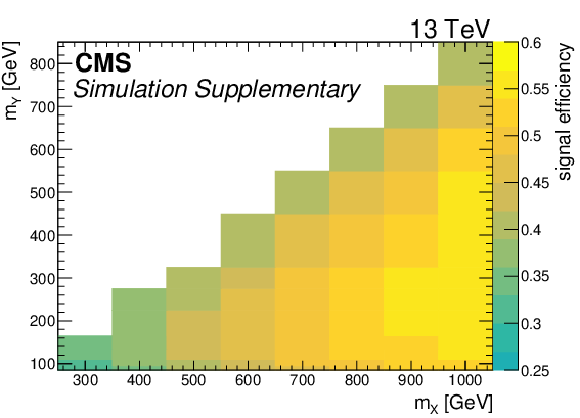
png pdf |
Additional Figure 1:
Variation in signal efficiency for the production of a resonance X decaying, via HY, into a final state of two photons and two bottom quarks, as a function of $ m_{\mathrm{X}} $ and $ m_{\mathrm{Y}} $ using the analysis event selection described in the paper. |

png pdf |
Additional Figure 2:
Observed local p-value as a function of $ m_{\text{X}} $ and $ m_{\text{Y}} $. |
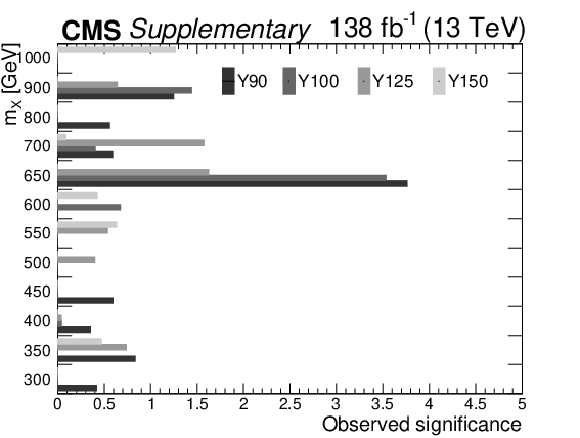
png pdf |
Additional Figure 3:
Bar graph representation of local significance for different $ m_{\text{Y}} $ hypotheses. |
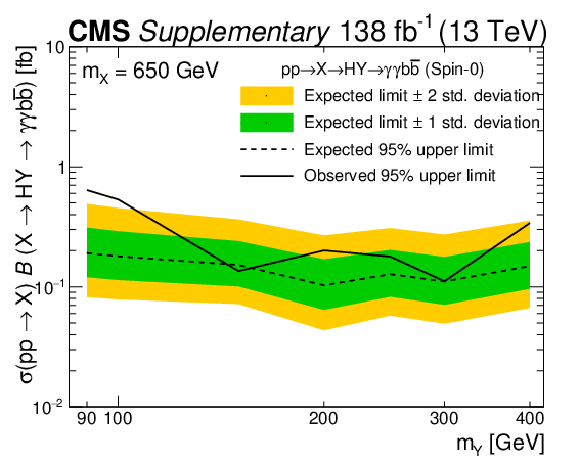
png pdf |
Additional Figure 4:
Observed and expected upper limits at 95% CL for $ m_{X}= $ 650 GeV as function of $ m_{Y} $. The dashed and solid black lines represent expected and observed limits, respectively. The green and yellow bands represent the 1 and 2 standard deviations for the expected limit. |

png pdf |
Additional Figure 5:
Observed and expected upper limits at 95% CL for $ m_{X}=$ 550-700 GeV as function of $ m_{Y} $. The dashed and solid black lines represent expected and observed limits, respectively. The green and yellow bands represent the 1 and 2 standard deviations for the expected limit. Limits are scaled with the order of 10 depending upon $ m_{X} $ as labelled in the figure. |
| References | ||||
| 1 | ATLAS Collaboration | Observation of a new particle in the search for the standard model Higgs boson with the ATLAS detector at the LHC | PLB 716 (2012) 1 | 1207.7214 |
| 2 | CMS Collaboration | Observation of a new boson at a mass of 125 GeV with the CMS experiment at the LHC | PLB 716 (2012) 30 | CMS-HIG-12-028 1207.7235 |
| 3 | CMS Collaboration | Observation of a new boson with mass near 125 GeV in pp collisions at $ \sqrt{s} = $ 7 and 8 TeV | JHEP 06 (2013) 081 | CMS-HIG-12-036 1303.4571 |
| 4 | S. Weinberg | A model of leptons | PRL 19 (1967) 1264 | |
| 5 | Sheldon L. Glashow | Partial-symmetries of weak interactions | Nucl. Phys. 22 579, 1961 | |
| 6 | G. 't Hooft and M. Veltman | Regularization and renormalization of gauge fields | Nucl. Phys. B 44 189, 1972 | |
| 7 | P. W. Higgs | Broken symmetries, massless particles and gauge fields | PL 12 (1964) 132 | |
| 8 | P. W. Higgs | Broken symmetries and the masses of gauge bosons | PRL 13 (1964) 508 | |
| 9 | CMS Collaboration | A portrait of the Higgs boson by the CMS experiment ten years after the discovery | Nature 607 (2022) 60 | CMS-HIG-22-001 2207.00043 |
| 10 | L. Randall and R. Sundrum | An alternative to compactification | PRL 83 (1999) 4690 | hep-th/9906064 |
| 11 | L. Randall and R. Sundrum | Large mass hierarchy from a small extra dimension | PRL 83 (1999) 3370 | hep-ph/9905221 |
| 12 | W. D. Goldberger and M. B. Wise | Modulus stabilization with bulk fields | PRL 83 (1999) 4922 | hep-ph/9907447 |
| 13 | C. Csáki, M. Graesser, L. Randall, and J. Terning | Cosmology of brane models with radion stabilization | PRD 62 (2000) 045015 | hep-ph/9911406 |
| 14 | C. Csáki, M. L. Graesser, and G. D. Kribs | Radion dynamics and electroweak physics | PRD 63 (2001) 065002 | hep-th/0008151 |
| 15 | H. Davoudiasl, J. L. Hewett, and T. G. Rizzo | Phenomenology of the Randall--Sundrum Gauge Hierarchy Model | PRL 84 (2000) 2080 | hep-ph/9909255 |
| 16 | O. DeWolfe, D. Z. Freedman, S. S. Gubser, and A. Karch | Modeling the fifth dimension with scalars and gravity | PRD 62 (2000) 046008 | hep-th/9909134 |
| 17 | K. Agashe, H. Davoudiasl, G. Perez, and A. Soni | Warped gravitons at the CERN LHC and beyond | PRD 76 (2007) 036006 | hep-ph/0701186 |
| 18 | A. Carvalho | Gravity particles from Warped Extra Dimensions, predictions for LHC | 2014 | 1404.0102 |
| 19 | Yu. A. Golfand and E. P. Likhtman | Extension of the algebra of Poincaré group generators and violation of p invariance | JETP Lett. 13 (1971) 323 | |
| 20 | J. Wess and B. Zumino | Supergauge transformations in four-dimensions | NPB 70 (1974) 39 | |
| 21 | P. Fayet | Supergauge invariant extension of the Higgs mechanism and a model for the electron and its neutrino | NPB 90 (1975) 104 | |
| 22 | P. Fayet | Spontaneously broken supersymmetric theories of weak, electromagnetic and strong interactions | PLB 69 (1977) 489 | |
| 23 | U. Ellwanger, C. Hugonie, and A. M. Teixeira | The Next-to-Minimal Supersymmetric Standard Model | Phys. Rept. 496 (2010) 1 | 0910.1785 |
| 24 | M. Maniatis | The Next-to-Minimal Supersymmetric extension of the Standard Model reviewed | Int. J. Mod. Phys. A 25 (2010) 3505 | 0906.0777 |
| 25 | J. E. Kim and H. P. Nilles | The $ \mu $-problem and the strong CP problem | PLB 138 (1984) 150 | |
| 26 | T. Robens, T. Stefaniak, and J. Wittbrodt | Two-real-scalar-singlet extension of the SM: LHC phenomenology and benchmark scenarios | EPJC 80 (2020) 151 | 1908.08554 |
| 27 | D. de Florian et al. | Handbook of LHC Higgs cross sections: 4. Deciphering the nature of the Higgs sector | CERN-2017-002-M, 2016 | 1610.07922 |
| 28 | CMS Collaboration | Search for Higgs boson pair production in the $ \gamma\gamma\mathrm{b\overline{b}} $ final state in pp collisions at $ \sqrt{s}= $ 13 TeV | PLB 788 (2019) 7 | CMS-HIG-17-008 1806.00408 |
| 29 | CMS Collaboration | Search for nonresonant Higgs boson pair production in final states with two bottom quarks and two photons in proton-proton collisions at $ \sqrt{s} = $ 13 TeV | JHEP 03 (2021) 257 | CMS-HIG-19-018 2011.12373 |
| 30 | CMS Collaboration | HEPData record for this analysis | link | |
| 31 | CMS Collaboration | The CMS experiment at the CERN LHC | JINST 3 (2008) S08004 | |
| 32 | CMS Collaboration | The CMS trigger system | JINST 12 (2017) P01020 | CMS-TRG-12-001 1609.02366 |
| 33 | CMS Collaboration | Performance of the CMS Level-1 trigger in proton-proton collisions at $ \sqrt{s} = $ 13 TeV | JINST 15 (2020) P10017 | CMS-TRG-17-001 2006.10165 |
| 34 | CMS Collaboration | The CMS high level trigger | EPJC 46 (2006) 605 | hep-ex/0512077 |
| 35 | CMS Collaboration | Particle-flow reconstruction and global event description with the CMS detector | JINST 12 (2017) P10003 | CMS-PRF-14-001 1706.04965 |
| 36 | CMS Collaboration | Measurements of Higgs boson properties in the diphoton decay channel in proton-proton collisions at $ \sqrt{s} = $ 13 TeV | JHEP 11 (2018) 185 | CMS-HIG-16-040 1804.02716 |
| 37 | E. Spyromitros-Xioufis, G. Tsoumakas, W. Groves, and I. Vlahavas | Multi-target regression via input space expansion: treating targets as inputs | Machine Learning 104 (2016) 55 | 1211.6581 |
| 38 | CMS Collaboration | Electron and photon reconstruction and identification with the CMS experiment at the CERN LHC | JINST 16 (2021) P05014 | CMS-EGM-17-001 2012.06888 |
| 39 | CMS Collaboration | Performance of photon reconstruction and identification with the CMS detector in proton-proton collisions at $ \sqrt{s} = $ 8 TeV | JINST 10 (2015) P08010 | CMS-EGM-14-001 1502.02702 |
| 40 | CMS Collaboration | A measurement of the Higgs boson mass in the diphoton decay channel | PLB 805 (2020) 135425 | CMS-HIG-19-004 2002.06398 |
| 41 | M. Cacciari, G. P. Salam, and G. Soyez | The anti-$ k_{\mathrm{T}} $ jet clustering algorithm | JHEP 04 (2008) 063 | 0802.1189 |
| 42 | M. Cacciari, G. P. Salam, and G. Soyez | FastJet user manual | EPJC 72 (2012) 1896 | 1111.6097 |
| 43 | M. Cacciari and G. P. Salam | Pileup subtraction using jet areas | PLB 659 (2008) 119 | 0707.1378 |
| 44 | CMS Collaboration | Jet energy scale and resolution in the CMS experiment in pp collisions at 8 TeV | JINST 12 (2017) P02014 | CMS-JME-13-004 1607.03663 |
| 45 | CMS Collaboration | A deep neural network for simultaneous estimation of b jet energy and resolution | Comput. Softw. Big Sci. 4 (2020) 10 | CMS-HIG-18-027 1912.06046 |
| 46 | CMS Collaboration | Performance of missing transverse momentum reconstruction in proton-proton collisions at $ \sqrt{s} = $ 13 TeV using the CMS detector | JINST 14 (2019) P07004 | CMS-JME-17-001 1903.06078 |
| 47 | CMS Collaboration | Precision luminosity measurement in proton-proton collisions at $ \sqrt{s} = $ 13 TeV in 2015 and 2016 at CMS | EPJC 81 (2021) 800 | CMS-LUM-17-003 2104.01927 |
| 48 | CMS Collaboration | CMS luminosity measurement for the 2017 data-taking period at $ \sqrt{s} = $ 13 TeV | CMS Physics Analysis Summary, 2018 link |
CMS-PAS-LUM-17-004 |
| 49 | CMS Collaboration | CMS luminosity measurement for the 2018 data-taking period at $ \sqrt{s} = $ 13 TeV | CMS Physics Analysis Summary, 2019 CMS-PAS-LUM-18-002 |
CMS-PAS-LUM-18-002 |
| 50 | J. Alwall et al. | The automated computation of tree-level and next-to-leading order differential cross sections, and their matching to parton shower simulations | JHEP 07 (2014) 079 | 1405.0301 |
| 51 | A. Alloul et al. | FeynRules 2.0 --- A complete toolbox for tree-level phenomenology | Comput. Phys. Commun. 185 (2014) 2250 | 1310.1921 |
| 52 | T. Gleisberg et al. | Event generation with SHERPA 1.1 | JHEP 02 (2009) 007 | 0811.4622 |
| 53 | T. Sjöstrand et al. | An introduction to PYTHIA 8.2 | Comput. Phys. Commun. 191 (2015) 159 | 1410.3012 |
| 54 | P. Nason | A new method for combining NLO QCD with shower Monte Carlo algorithms | JHEP 11 (2004) 040 | hep-ph/0409146 |
| 55 | S. Frixione, P. Nason, and C. Oleari | Matching NLO QCD computations with Parton Shower simulations: the POWHEG method | JHEP 11 (2007) 070 | 0709.2092 |
| 56 | S. Alioli, P. Nason, C. Oleari, and E. Re | A general framework for implementing NLO calculations in shower Monte Carlo programs: the POWHEG BOX | JHEP 06 (2010) 043 | 1002.2581 |
| 57 | E. Bagnaschi, G. Degrassi, P. Slavich, and A. Vicini | Higgs production via gluon fusion in the POWHEG approach in the SM and in the MSSM | JHEP 02 (2012) 088 | 1111.2854 |
| 58 | M. Wiesemann et al. | Higgs production in association with bottom quarks | JHEP 02 (2015) | |
| 59 | CMS Collaboration | Event generator tunes obtained from underlying event and multiparton scattering measurements | EPJC 76 (2016) 155 | CMS-GEN-14-001 1512.00815 |
| 60 | CMS Collaboration | Extraction and validation of a new set of CMS PYTHIA8 tunes from underlying-event measurements | EPJC 80 (2020) 4 | CMS-GEN-17-001 1903.12179 |
| 61 | NNPDF Collaboration | Parton distributions for the LHC Run II | JHEP 04 (2015) 040 | 1410.8849 |
| 62 | NNPDF Collaboration | Parton distributions from high-precision collider data | EPJC 77 (2017) 663 | 1706.00428 |
| 63 | S. Carrazza, J. I. Latorre, J. Rojo, and G. Watt | A compression algorithm for the combination of PDF sets | EPJC 75 (2015) 474 | 1504.06469 |
| 64 | J. Butterworth et al. | PDF4LHC recommendations for LHC Run II | JPG 43 (2016) 023001 | 1510.03865 |
| 65 | S. Dulat et al. | New parton distribution functions from a global analysis of quantum chromodynamics | PRD 93 (2016) 033006 | 1506.07443 |
| 66 | L. A. Harland-Lang, A. D. Martin, P. Motylinski, and R. S. Thorne | Parton distributions in the LHC era: MMHT 2014 PDFs | EPJC 75 (2015) 204 | 1412.3989 |
| 67 | GEANT4 Collaboration | GEANT4---a simulation toolkit | NIM A 506 (2003) 250 | |
| 68 | CMS Collaboration | Observation of the diphoton decay of the Higgs boson and measurement of its properties | EPJC 74 (2014) 3076 | CMS-HIG-13-001 1407.0558 |
| 69 | CMS Collaboration | Pileup mitigation at CMS in 13 TeV data | JINST 15 (2020) P09018 | CMS-JME-18-001 2003.00503 |
| 70 | B. Vormwald | The CMS phase-1 pixel detector - experience and lessons learned from two years of operation | JINST 14 (2019) C07008 | |
| 71 | CMS Collaboration | Identification of heavy-flavour jets with the CMS detector in pp collisions at 13 TeV | JINST 13 (2018) P05011 | CMS-BTV-16-002 1712.07158 |
| 72 | E. Bols et al. | Jet Flavour Classification Using DeepJet | JINST 15 (2020) P12012 | 2008.10519 |
| 73 | CMS Collaboration | Performance of the DeepJet b tagging algorithm using 41.9 fb$^{-1}$ of data from proton-proton collisions at 13 TeV with Phase 1 CMS detector | CMS Detector Performance Note CMS-DP-2018-058, 2018 CDS |
|
| 74 | N. Kumar and S. P. Martin | LHC search for di-Higgs decays of stoponium and other scalars in events with two photons and two bottom jets | PRD 90 (2014) 055007 | 1404.0996 |
| 75 | T. Chen and C. Guestrin | XGBoost: A scalable tree boosting system | in nd ACM SIGKDD International Conference on Knowledge Discovery and Data Mining, KDD, . ACM, New York, NY, USA, 2016 Proceedings of the 2 (2016) 785 |
|
| 76 | M. Gouzevitch et al. | Scale-invariant resonance tagging in multijet events and new physics in Higgs pair production | JHEP 07 (2013) 148 | 1303.6636 |
| 77 | T. Hastie, R. Tibshirani, and J. Friedman | The elements of statistical learning | Springer-Verlag New York, 2nd edition, 2009 link |
|
| 78 | J. C. Collins and D. E. Soper | Angular distribution of dileptons in high-energy hadron collisions | PRD 16 (1977) 2219 | |
| 79 | G. Punzi | Sensitivity of searches for new signals and its optimization | in Statistical Problems in Particle Physics, Astrophysics, and Cosmology, L. Lyons, R. Mount, and R. Reitmeyer, eds, 2003 | physics/0308063 |
| 80 | M. J. Oreglia | A study of the reactions $ \psi^\prime \to \gamma \gamma \psi $ | PhD thesis, Stanford University, SLAC Report SLAC-R-236, 1980 link |
|
| 81 | P. D. Dauncey, M. Kenzie, N. Wardle, and G. J. Davies | Handling uncertainties in background shapes: the discrete profiling method | JINST 10 (2015) P04015 | 1408.6865 |
| 82 | D. L. Hahs-Vaughn and R. G. Lomax | Statistical Concepts --- A Second Course | Routledge New York, 4th edition, 2012 link |
|
| 83 | CMS Collaboration | Jet algorithms performance in 13 TeV data | CMS Physics Analysis Summary, 2017 CMS-PAS-JME-16-003 |
CMS-PAS-JME-16-003 |
| 84 | CMS Collaboration | Measurement of the Inclusive $ W $ and $ Z $ Production Cross Sections in pp Collisions at $ \sqrt{s}= $ 7 TeV | JHEP 10 (2011) 132 | CMS-EWK-10-005 1107.4789 |
| 85 | E. Gross and O. Vitells | Trial factors for the look elsewhere effect in high energy physics | EPJC 70 (2010) 525 | 1005.1891 |
| 86 | A. L. Read | Presentation of search results: the CL$ _s $ technique | JPG 28 (2002) 2693 | |
| 87 | ATLAS and CMS Collaborations, LHC Higgs Combination Group | Procedure for the LHC Higgs boson search combination in summer 2011 | CMS/ATLAS joint note ATL-PHYS-PUB-2011-11, /005, 2011 CMS NOTE 201 (2011) 1 |
|
| 88 | T. Junk | Confidence level computation for combining searches with small statistics | NIM A 434 (1999) 435 | hep-ex/9902006 |
| 89 | G. Cowan, K. Cranmer, E. Gross, and O. Vitells | Asymptotic formulae for likelihood-based tests of new physics | EPJC 71 (2011) 1554 | 1007.1727 |
| 90 | CMS Collaboration | Combination of searches for Higgs boson pair production in proton-proton collisions at $ \sqrt{s} = $ 13 TeV | PRL 122 (2019) 121803 | CMS-HIG-17-030 1811.09689 |
| 91 | ATLAS Collaboration | Search for Higgs boson pair production in the two bottom quarks plus two photons final state in $ pp $ collisions at $ \sqrt{s}= $ 13 TeV with the ATLAS detector | PRD 106 (2022) 052001 | 2112.11876 |
| 92 | U. Ellwanger et al. | Benchmark lines and planes for Higgs-to-Higgs decays in the NMSSM | 2024 | 2403.15046 |
| 93 | U. Ellwanger and C. Hugonie | NMHDECAY 2.0: An Updated program for sparticle masses, Higgs masses, couplings and decay widths in the NMSSM | Comput. Phys. Commun. 175 (2006) 290 | hep-ph/0508022 |
| 94 | J. Baglio et al. | NMSSMCALC: A Program Package for the Calculation of Loop-Corrected Higgs Boson Masses and Decay Widths in the (Complex) NMSSM | 2014 link |
1312.4788 |

|
Compact Muon Solenoid LHC, CERN |

|

|

|

|

|

|